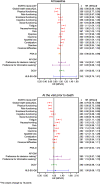Characteristics and patient-reported outcomes associated with dropout in severely affected oncological patients: an exploratory study
- PMID: 33879087
- PMCID: PMC8059010
- DOI: 10.1186/s12874-021-01259-0
Characteristics and patient-reported outcomes associated with dropout in severely affected oncological patients: an exploratory study
Abstract
Background: Patient-reported outcome measures (PROMs) are commonly-used surrogates for clinical outcomes in cancer research. When researching severe diseases such as cancer, it is difficult to avoid the problem of incomplete questionnaires from drop-outs or missing data from patients who pass away during the observation period. The aim of this exploratory study was to explore patient characteristics and the patient-reported outcomes associated with the time-to-dropout.
Methods: In an Oncological Social Care Project (OSCAR) study, the condition of the participants was assessed four times within 12 months (t0: baseline, t1: 3 months, t2: 6 months, and t3: 12 months) by validated PROMs. We performed competing-risk regressions based on Fine and Gray's proportional sub-distribution hazards model for exploring factors associated with time-to-dropout. Death was considered a competing risk.
Results: Three hundred sixty-two participants were analyzed in the study. 193 (53.3%) completed a follow-up after 12 months, 67 (18.5%) patients dropped out, and 102 patients (28.2%) died during the study period. Poor subjective social support was related to a higher risk of drop-out (SHR = 2.10; 95%CI: 1.01-4.35). Lower values in health-related quality of life were related to drop-out and death. The sub-scales global health status/QoL, role functioning, physical functioning, and fatigue symptom in the EORTC QLQ-C30 were key characteristics of early drop-out.
Conclusion: Severely affected cancer patients with poor social support and poor quality of life seem more likely to drop out of studies than patients with higher levels of social support and a better quality of life. This should be considered when planning studies to assess advanced cancer patients. Methods of close continued monitoring should be actively used when patient experiences a substantial deterioration in their health-related quality of life and symptoms during the study. Results for such studies have to be interpreted with caution in light of specific drop-out mechanisms.
Trial registration: OSCAR study was registered to the German Clinical Trials Register (DRKS-ID: DRKS00013640 ). Registered 29 December 2017.
Keywords: Advanced cancer; Attrition; Cancer; Health-related quality of life; Monotone missing data; Non-compliance; Patient-reported outcome measures.
Conflict of interest statement
The authors declare that they have no competing interests.
Figures




Similar articles
-
Improving quality of life in cancer patients through higher participation and health literacy: study protocol for evaluating the oncological social care project (OSCAR).BMC Health Serv Res. 2019 Oct 26;19(1):754. doi: 10.1186/s12913-019-4585-0. BMC Health Serv Res. 2019. PMID: 31655598 Free PMC article. Clinical Trial.
-
Patient-reported outcomes with atezolizumab plus bevacizumab versus sorafenib in patients with unresectable hepatocellular carcinoma (IMbrave150): an open-label, randomised, phase 3 trial.Lancet Oncol. 2021 Jul;22(7):991-1001. doi: 10.1016/S1470-2045(21)00151-0. Epub 2021 May 27. Lancet Oncol. 2021. PMID: 34051880 Clinical Trial.
-
Nivolumab versus standard, single-agent therapy of investigator's choice in recurrent or metastatic squamous cell carcinoma of the head and neck (CheckMate 141): health-related quality-of-life results from a randomised, phase 3 trial.Lancet Oncol. 2017 Aug;18(8):1104-1115. doi: 10.1016/S1470-2045(17)30421-7. Epub 2017 Jun 23. Lancet Oncol. 2017. PMID: 28651929 Free PMC article. Clinical Trial.
-
Standardising the Assessment of Patient-reported Outcome Measures in Localised Prostate Cancer. A Systematic Review.Eur Urol Oncol. 2022 Apr;5(2):153-163. doi: 10.1016/j.euo.2021.10.004. Epub 2021 Nov 14. Eur Urol Oncol. 2022. PMID: 34785188
-
Quality of life assessment in Hodgkin's disease: a new comprehensive approach. First experiences from the EORTC/GELA and GHSG trials. EORTC Lymphoma Cooperative Group. Groupe D'Etude des Lymphomes de L'Adulte and German Hodgkin Study Group.Ann Oncol. 1998;9 Suppl 5:S147-54. doi: 10.1093/annonc/9.suppl_5.s147. Ann Oncol. 1998. PMID: 9926255 Review.
Cited by
-
Longitudinal assessment of real-world patient adherence: a 12-month electronic patient-reported outcomes follow-up of women with early breast cancer undergoing treatment.Support Care Cancer. 2024 May 14;32(6):344. doi: 10.1007/s00520-024-08547-7. Support Care Cancer. 2024. PMID: 38740611 Free PMC article.
-
Changes in global quality of life after treatment with immune checkpoint inhibitors in patients receiving different treatment regimens for advanced stage lung cancer in the Netherlands: a 2015-2021 cohort study.BMJ Open. 2025 Feb 20;15(2):e098062. doi: 10.1136/bmjopen-2024-098062. BMJ Open. 2025. PMID: 39979046 Free PMC article.
-
Living lab modelling as a pilot study assessing the potential psychological health benefits of forest environment for cancer survivors.Obstet Gynecol Sci. 2024 Jul;67(4):404-413. doi: 10.5468/ogs.24035. Epub 2024 Jun 12. Obstet Gynecol Sci. 2024. PMID: 38987994 Free PMC article.
-
User expectations and experiences of an assistive robotic arm in amyotrophic lateral sclerosis: a multicenter observational study.Neurol Res Pract. 2024 Aug 23;6(1):42. doi: 10.1186/s42466-024-00342-3. Neurol Res Pract. 2024. PMID: 39180054 Free PMC article.
-
Improving the Implementation of Patient-Reported Outcome Measure in Clinical Practice: Tackling Current Challenges With Innovative Digital Communication Technologies.J Med Internet Res. 2025 Feb 5;27:e60777. doi: 10.2196/60777. J Med Internet Res. 2025. PMID: 39908539 Free PMC article.
References
-
- Basch E, Deal AM, Kris MG, Scher HI, Hudis CA, Sabbatini P, Rogak L, Bennett AV, Dueck AC, Atkinson TM, Chou JF, Dulko D, Sit L, Barz A, Novotny P, Fruscione M, Sloan JA, Schrag D. Symptom monitoring with patient-reported outcomes during routine cancer treatment: a randomized controlled trial. J Clin Oncol. 2016;34(6):557–565. doi: 10.1200/JCO.2015.63.0830. - DOI - PMC - PubMed
-
- Bernhard J, Cella DF, Coates AS, Fallowfield L, Ganz PA, Moinpour CM, Mosconi P, Osoba D, Simes J, Hurny C. Missing quality of life data in cancer clinical trials: serious problems and challenges. Stat Med. 1998;17(5–7):517–532. doi: 10.1002/(SICI)1097-0258(19980315/15)17:5/7<517::AID-SIM799>3.0.CO;2-S. - DOI - PubMed
Publication types
MeSH terms
Grants and funding
LinkOut - more resources
Full Text Sources
Other Literature Sources

